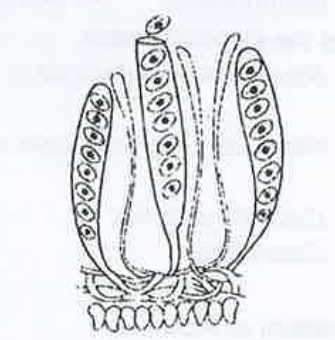The reproductive structures in ferns and mosses is
seeds
sori
spores
zygospores
The correct Answer is:C
To answer the question regarding the reproductive structures in ferns and mosses, we can follow these steps:
1. Identify the Groups: Recognize that ferns and mosses are both part of the plant kingdom, specifically under the division Pteridophyta for ferns and Bryophyta for mosses.
2. Understand Reproductive Structures: In these groups, the reproductive structures are crucial for their life cycle. Both ferns and mosses reproduce through spores rather than seeds.
3. Life Cycle Stages: The life cycle of ferns and mosses involves two main stages:
- Sporophytic Stage: This is the diploid phase where the plant produces spores through meiosis.
- Gametophytic Stage: This is the haploid phase where the spores germinate and develop into gametophytes, which produce male and female gametes.
4. Key Component: The formation of spores is the key component of their reproduction. Spores are produced in structures called sporangia, which are found on the sporophyte.
5. Conclusion: Since the question asks for the reproductive structures in ferns and mosses, the correct answer is "spores."
Final Answer:
The reproductive structures in ferns and mosses are spores.
---
- Sporophytic Stage: This is the diploid phase where the plant produces spores through meiosis.
- Gametophytic Stage: This is the haploid phase where the spores germinate and develop into gametophytes, which produce male and female gametes.
The reproductive structures in ferns and mosses are spores.
Topper's Solved these Questions
- REPRODUCTION IN ORGANISMSBook:AAKASH SERIESChapter:REPRODUCTION IN ORGANISMSExercise:Exercise-II
Explore 42 Videos
- REPRODUCTION IN ORGANISMSBook:AAKASH SERIESChapter:REPRODUCTION IN ORGANISMSExercise:Exercise-II (Exemplar Questions)
Explore 18 Videos
- MORPHOLOGY OF FLOWERING PLANTS Book:AAKASH SERIESChapter:MORPHOLOGY OF FLOWERING PLANTS Exercise:EXERCISE - III (Previous AIPMT/NEET Questions)
Explore 41 Videos
- REPRODUCTIVE HEALTH Book:AAKASH SERIESChapter:REPRODUCTIVE HEALTH Exercise:EXERCISE-III (PREVIOUS AIPMT/NEET QUESTIONS)
Explore 21 Videos
Similar Questions
Knowledge Check
Select the correct pattern of arrangement of reproductive structures for gymnosperms.
Aspores→Sporophyll→sporangia→strobiliBspores→sporangia→sporophylls→strobiliCsporangia→sporophylls→spores→strobiliDspores→sporangia→strobili→sporophyllsRefer to the given figure of reproductive structure of Papaver and identify X and Y
 AXYSyncarpous ovaryStigmaBXYStigmaSyncarpous ovaryCXYThalamusApocarpous ovaryDXYApocarpous ovaryThalamus
AXYSyncarpous ovaryStigmaBXYStigmaSyncarpous ovaryCXYThalamusApocarpous ovaryDXYApocarpous ovaryThalamusFerns are
Aunicellular prokaryotesBunicellular eukaryotesCmulticellular prokaryotesDmulticellular eukaryotes
Most common special asexual reproductive structure seen in members of algae is
View SolutionAsci are sexually reproductive structures formed in
View SolutionCan asexual reproduction occur through the formation of specialised reproductive structures ?
Mention name of two such structures.
View SolutionIdentify the reproductive structure of the Figure shown and name the orgainsm they are being released from
View SolutionIn Riccia, the female reproductive structures are called:
View Solution
